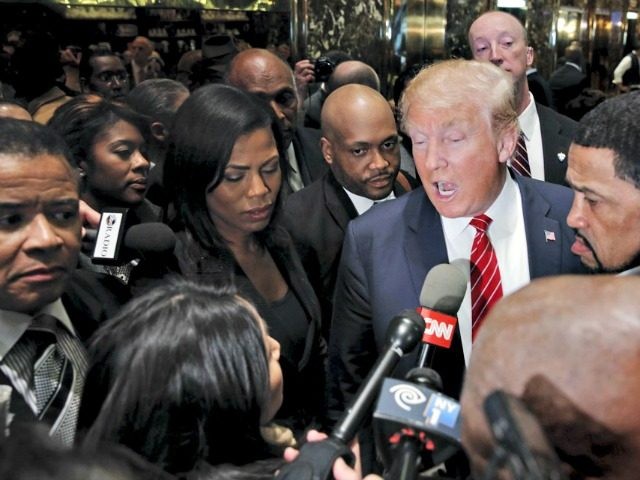The Los Angeles Times/USC Dornsife national tracking poll of the presidential campaign picked up a sharp uptick in African-American support for Republican nominee Donald J. Trump, which it now pegs at 14.6 percent.
When the “Daybreak” poll began July 10, Trump‘s support among black voters was 4.6 percent and he fluctuated between 5.4 percent Aug. 1 and 2.5 percent Aug. 11.
The upswing in support for Trump–more than 500 percent above his low less than a week previous–comes after the New York City developer’s address Tuesday in the Milwaukee suburb of West Bend, Wisconsin. In that speech, Trump made his most direct play for African-American support in the campaign:
We reject the bigotry of Hillary Clinton which panders to and talks down to communities of color and sees them only as votes, not as individual human beings worthy of a better future. She doesn’t care at all about the hurting people of this country, or the suffering she has caused them. The African-American community has been taken for granted for decades by the Democratic Party. It’s time to break with the failures of the past – I want to offer Americans a new future.
The speech itself was a risk because the Trump campaign had planned the event before Sunday’s riots less than an hour south in the black neighborhoods of Wisconsin’s largest city. The main theme of the speech was law and order and the need to back up law enforcement in a climate where police officers are now tagged as the enemy of the common people.
Trump took that straight on:
The main victims of these riots are law-abiding African-American citizens living in these neighborhoods. It is their jobs, their homes, their schools and communities which will suffer as a result. There is no compassion in tolerating lawless conduct. Crime and violence is an attack on the poor, and will never be accepted in a Trump Administration.
Writing for NetRightDaily, the news website for Americans for Limited Government, Robert Romano points out that given the apparent success of Trump’s appeal to black voters, he now has the formula to appeal to other communities that are the foundation of the Democratic Party’s voter turnout model. Roman writes:
In principle, if Trump were to deftly deliver the same message again to a wider audience, he could begin to consolidate a growing base of supporters among blacks that did not exist three days ago. Could he grow that base?
Because, if the result were to be replicated in cities across America, November might not even be close.
Who saw this coming?
Apparently, after a generation of failure in America’s inner cities, the events in Milwaukee have caused a huge crack in the traditional Democrat coalition that has included blacks since the Great Depression — and Trump is exploiting it by promising to restore law and order. He blamed Democrat one-party rule in the cities on the problems facing blacks today.
And it resonated.
In the general population poll, Trump trails Democratic nominee Hillary R. Clinton with 43.4 percent to her 44 percent. Trump’s high water mark with the general population sample was July 27, when he hit 47.4 and his summer nadir with the general population was his 41.6 percent that he bounced off of Aug. 13.
Clinton’s support with African Americans began July 10 at 81.5 percent and hit its low point July 27 at 80.4 percent. Thus far, the Democrat’s highest support, according to the poll, was Aug. 12, when it hit 90.3 percent. President Barack Obama in 2012 won 93 percent of 67 percent African-American turnout. That surge of support from black voters was his margin of victory in seven states for a total of 112 electoral votes.
The Daybreak poll run by the University of Southern California’s Dornsife Center for Economic and Social Research is a daily measure of 3,000 eligible voters. In normal polling practice, so-called tracking polls have a wider margin of error when they are weighted against previous polls like this one. The problem is that margins of error can become cumulative. The center posts that they have 95 percent confidence in their data for each day.

COMMENTS
Please let us know if you're having issues with commenting.